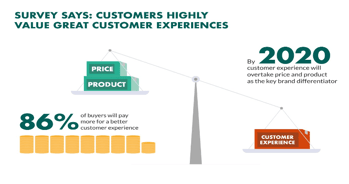The current marketing environment has changed drastically. Customers are often in need of assistance and expect smooth interactions with the company. Hence, leading businesses are focused on using technology to humanize their labels and develop service models to withstand this ever-changing business environment.
Marketing and Technology
 Surveys show that 86 percent of customers are willing to pay more for a better customer experience. It also stated that about 75 percent of companies believe that they are customer-centric, but only 30 percent of customers think that it’s true.
Surveys show that 86 percent of customers are willing to pay more for a better customer experience. It also stated that about 75 percent of companies believe that they are customer-centric, but only 30 percent of customers think that it’s true.
Usually, whenever a customer encounters a problem, a salesperson or call center representative provides them with discounts, coupons, or store credits, or in the case of B2B SaaS models, free seats or a complimentary month. Although this temporarily relieves angry customers, it does not really impress them. There is so much more than just coupons and discounts to fully satisfy a customer’s needs.
Technology is making an increasingly significant contribution to customer service. To simplify the customer experience, many companies are using big data, chatbots, and AI recommendations. This dramatically reduces the burden on customer support agents from repeatedly answering simple customer questions. With technology, the customer support agents can now focus on more complex customer concerns that require a human element.
Enhanced Customer Support
It is quite challenging to fully meet the needs of every customer. Fortunately, technology provides businesses with various tools to create a great customer experience. Here’s how:
1. High Touch Technology
High-touch technology has made things a lot easier for everyone. It enables you to create touchpoints that never existed before. It uses an automated online self-service portal to respond to customer’s inquires and for business transactions.
With online tools like chatbots, Facebook messenger and Alexa, service agents can reach the customers whenever needed. For instance, Nordstrom uses chatbots to provide personalized shopping recommendations, while Zurich uses chatbots to help clients file insurance claims.
Customers are also increasingly appreciating the clever use of this technology. 71 percent of customers were pleased with their smartphone voice assistant like Siri and 62 percent of customers said they were satisfied with the chat assistant on the company’s website.
2. ‘Phygital’ Retail Space
Several companies combine the best of physical and digital shopping experiences into one incredible immersion.
Phygital combines both online and offline environments. By using the best aspects from each area it creates a more comprehensive and satisfying customer experience. It leverages the best elements from the digital retail experience like speed, immediacy, and immersion. This technique is a great way to satisfy a demanding, over-connected consumer and meet their requirements across multiple platforms.
The Nike SoHo Neighborhood in New York is the perfect example of this. As soon as a customer enters the store, the in-store assistant gives personalized recommendations via cameras and sensors installed in the store. Customers are captured from multiple angles Customers can access all of this data online or through the Nike app. Nike uses this data to further personalize the customer experience the next time they visit the store.
3. Artificial intelligence (AI) and Machine Learning
 Artificial intelligence and machine learning studies consumer behavior and purchasing habits. It then transforms the raw data into meaningful insights which retailers can view to predict their customer’s future purchases.
Artificial intelligence and machine learning studies consumer behavior and purchasing habits. It then transforms the raw data into meaningful insights which retailers can view to predict their customer’s future purchases.
AI and machine learning principles can be employed in many customer service areas. You can use AI to deliver customers to the right agents, offer more relevant solutions to customers, and more.
4. Omnichannel Approach
Omni-channel support is distinctly different from multi-channel support. Omni-channel synchronizes communication channels together, allowing teams and customers to work seamlessly with each other.
With organizations struggling to influence more touch points, it is easier than ever to meet customer needs across all channels in any setting. If a customer is curious about a business, he can connect with them directly via messenger or digital voice assistance. Customers can also get in contact with chatbots on the website. Retailers can satisfy and make customers happy by giving them more opportunities to connect with the brand.
Customer support is a critical and the most essential part of any successful business. Integrating technology into your customer support system is a win-win solution for both businesses and consumers. Most importantly, it gives you the ability to deliver a pleasant, engaging brand experience across all potential touchpoints. Good customer experiences generate a sense of community, continuity, and belonging.
Image Sources:
https://www.superoffice.com/blog/customer-experience-statistics/

|
About Kristin Mortis Kristin Mortis is a Marketing Manager with 8+ years of experience at TDInsights based out of Plano, Texas. She helps businesses deliver the strongest marketing turnaround with cutting-edge digital strategies and tools. She writes about B2B Marketing, Big Data, Artificial Intelligence, and other technological innovations. Connect with @KristinMortis on Twitter to learn about the emerging practices being implemented in the B2B segment. |
Looking For Startup Consultants ?
Call Pursho @ 0731-6725516
Telegram Group One Must Follow :
For Startups: https://t.me/daily_business_reads




